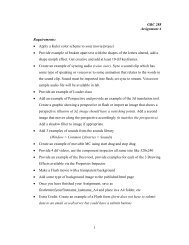Introducing Financial Accounting - CCSN Computer Graphics Program
Introducing Financial Accounting - CCSN Computer Graphics Program
Introducing Financial Accounting - CCSN Computer Graphics Program
Create successful ePaper yourself
Turn your PDF publications into a flip-book with our unique Google optimized e-Paper software.
wiL27041_ch01_002-047.indd Page 4 10/4/10 7:12:07 PM user-f499 /Volumes/204/MHBR211/wiL27041_disk1of1/0073527041/wiL27041_pagefiles<br />
Chapter Preview<br />
Today’s world is one of information — its preparation, communication,<br />
analysis, and use. <strong>Accounting</strong> is at the core of this<br />
information age. Knowledge of accounting gives us career<br />
opportunities and the insight to take advantage of them. This<br />
book introduces concepts, procedures, and analyses that help<br />
IMPORTANCE OF ACCOUNTING<br />
C1<br />
Importance of<br />
<strong>Accounting</strong><br />
• <strong>Accounting</strong><br />
information users<br />
• Opportunities in<br />
accounting<br />
Explain the purpose and<br />
importance of accounting.<br />
Real company names are<br />
printed in bold magenta.<br />
EXHIBIT 1.1<br />
<strong>Accounting</strong> Activities<br />
A Preview opens each chapter with a summary of topics covered.<br />
<strong>Introducing</strong> <strong>Financial</strong> <strong>Accounting</strong><br />
Fundamentals<br />
of <strong>Accounting</strong><br />
• Ethics—key concept<br />
• Generally accepted<br />
accounting principles<br />
• International standards<br />
us make better decisions, including career choices. In this<br />
chapter we describe accounting, the users and uses of accounting<br />
information, the forms and activities of organizations, and<br />
several accounting principles. We also introduce transaction<br />
analysis and financial statements.<br />
Transaction Analysis<br />
• <strong>Accounting</strong> equation<br />
• Transaction<br />
analysis—illustrated<br />
<strong>Financial</strong><br />
Statements<br />
• Income statement<br />
• Statement of<br />
retained earnings<br />
• Balance sheet<br />
• Statement of cash<br />
flows<br />
Why is accounting so popular on campuses? Why are there so many accounting jobs for graduates?<br />
Why is accounting so important to companies? Why do politicians and business leaders<br />
focus on accounting regulations? The answer is that we live in an information age, where that<br />
information, and its reliability, impacts the financial well-being of us all.<br />
<strong>Accounting</strong> is an information and measurement system that identifies, records, and communicates<br />
relevant, reliable, and comparable information about an organization’s business activities.<br />
Identifying business activities requires selecting transactions and events relevant to an<br />
organization. Examples are the sale of iPhones by Apple and the receipt of ticket money by<br />
TicketMaster. Recording business activities requires keeping a chronological log of transactions<br />
and events measured in dollars and classified and summarized in a useful format. Communicating<br />
business activities requires preparing accounting reports such as financial statements.<br />
It also requires analyzing and interpreting such reports. (The financial statements and notes of<br />
Research In Motion, the maker of BlackBerry, are shown in Appendix A near the end of this<br />
book. This appendix also shows the financial statements of Apple, Palm, and Nokia.) Exhibit 1.1<br />
summarizes accounting activities.<br />
We must guard against a narrow view of accounting. Our most common contact with accounting<br />
is through credit approvals, checking accounts, tax forms, and payroll. These experiences are<br />
limited and tend to focus on the recordkeeping parts of accounting. Recordkeeping, or<br />
bookkeeping, is the recording of transactions and events, either manually or electronically. This is<br />
just one part of accounting. <strong>Accounting</strong> also identifies and communicates information on transactions<br />
and events, and it includes the crucial processes of analysis and interpretation.<br />
Identifying Recording Communicating<br />
Select transactions and events Input, measure, and classify Prepare, analyze, and interpret









